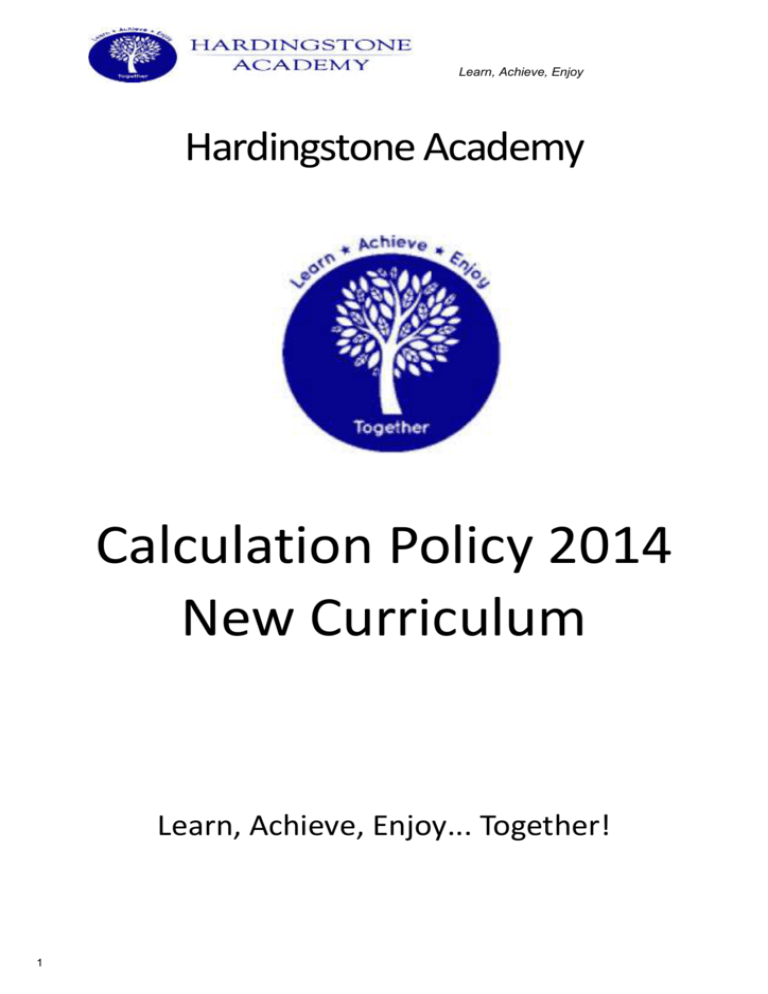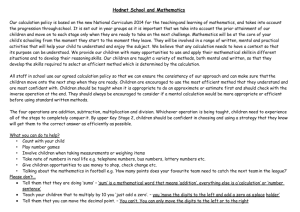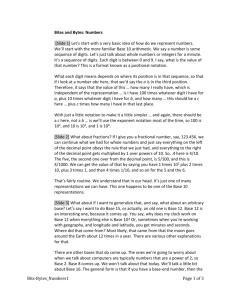Calculation Policy 2014
advertisement

Learn, Achieve, Enjoy Hardingstone Academy Calculation Policy 2014 New Curriculum Learn, Achieve, Enjoy... Together! 1 Learn, Achieve, Enjoy Addition Written methods for addition of whole numbers The aim is that children use mental methods when appropriate, but for calculations that they cannot do in their heads they use an efficient written method accurately and with confidence. Children are entitled to be taught and to acquire secure mental methods of calculation and one efficient written method of calculation for addition which they know they can rely on when mental methods are not appropriate. These notes show the stages in building up to using an efficient written method for addition of whole numbers by the end of Year 4. To add successfully, children need to be able to: recall all addition pairs to 9 + 9 and complements in 10; add mentally a series of one-digit numbers, such as 5 + 8 + 4; add multiples of 10 (such as 60 + 70) or of 100 (such as 600 + 700) using the related addition fact, 6 + 7, and their knowledge of place value; partition two-digit and three-digit numbers into multiples of 100, 10 and 1 in different ways. Note: It is important that children’s mental methods of calculation are practised on a regular basis and secured alongside their learning and use of an efficient written method for addition. Using and Applying Before children move onto the next stage in written calculation it is important that their skills are broadened through their use and application in a range of contexts (including money, time and other measures) 2 Learn, Achieve, Enjoy ADDITION Following on from number line/number track work Stage 1: The empty number line Steps in addition can be recorded on a number line. The steps often bridge through a multiple of 10. 8 + 7 = 15 Year 1: number bonds and Year 2 subtraction facts to 20. 48 + 36 = 84 Year 3 or: Use objects and pictures and write number sentences. Year 2: 2 digit add 1 digit. 2 digit add tens. Two 2 digit numbers. Adding three 1 digit numbers together. Year 3 Stage 2: Partitioning Record steps in addition using partitioning: 76 + 47 = 76 + 40 + 7 = 116 + 7 = 123 76 + 47 = 70 + 40 + 6 + 7 = 110 + 13 = 123 Year 3 Partitioned numbers are then written under one another: 47 40 7 76 70 6 110 13 12 Year 3: 3 digit number add ones 3 digit number add tens 3 digit number add hundreds or in a grid 40 7 70 6 110 13 6 Stage 3: Expanded method in columns Write the numbers in columns. Adding the tens first to Moving on to follow on from Partitioning Adding the ones first: 47 76 13 110 123 47 76 110 13 123 Year Year3 3 the ones Discuss how adding first same gives the ones first givesthe answer as adding the same answer as Discuss how the tens Refine adding the tens adding first. refine over time to first. over time adding adding the ones digits to the ones digits first Discuss first consistently. consistent how ly. adding Stage 4: Column method (efficient) Ask children to estimate first. 47 76 258 87 123 345 11 11 366 458 824 11 Year 4: to work with 4 digit numbers. Year 4 Children need to have experience of adding more than two numbers. Column addition remains efficient when used with larger whole numbers and decimals. Once learned, the method is quick and reliable. Year 5: 4 or more digits involved. Year 6: negative integers involved. 3 Learn, Achieve, Enjoy Subtraction Written methods for subtraction of whole numbers The aim is that children use mental methods when appropriate, but for calculations that they cannot do in their heads they use an efficient written method accurately and with confidence. Children are entitled to be taught and to acquire secure mental methods of calculation and one efficient written method of calculation for subtraction which they know they can rely on when mental methods are not appropriate. These notes show the stages in building up to using an efficient method for subtraction of up to 5 whole numbers by the end of Year 5. To subtract successfully, children need to be able to: recall all addition and subtraction facts to 20; subtract multiples of 10 (such as 160 – 70) using the related subtraction fact,16 – 7, and their knowledge of place value; partition two-digit and three-digit numbers into multiples of one hundred, ten and one in different ways (e.g. partition 74 into 70 + 4 or 60 + 14). Note: It is important that children’s mental methods of calculation are practised and secured alongside their learning and use of an efficient written method for subtraction. Using and Applying Before children move onto the next stage in written calculation it is important that their skills are broadened through their use and application in a range of contexts (including money, time and other measures). 4 Learn, Achieve, Enjoy SUBTRACTION Following on from number line /numeral track Stage 1: Using the empty number line (To be introduced before counting-up) Steps in subtraction can be recorded on a number line. The steps often bridge through a multiple of 10. 15 – 7 = 8 : 74 – 27 = 47 Worked out by counting back. Building on mental strategies of: Counting back to and Counting back from The steps may be recorded in a different order. Or combined. Either order is acceptable. Year 1 and Year 2 The counting-up method 2 2/3 digits or: Year 1: 1 and 2 digit numbers involved Year 2: 2 digit and 3 digit numbers involved. Year 3: 3 digit numbers involved. Year 4: 3 / 4 digit numbers involved. Year 5: 3 / 4 digit numbers involved and then a more efficient method should be chosen. With practice, children will need to record less information and decide whether to count back or forward. It is useful to ask children whether counting up or back is the more efficient for calculations such as 57 – 12, 86 – 77 or 43 – 28. 5 Learn, Achieve, Enjoy Stage 2: Partitioning Using the ‘Jump’ strategy. Retain the first number and partition the second 74 – 27 = 74 – 20 – 7 = 54 – 7 = 47 This requires children to subtract a single-digit number or a multiple of 10 from a two-digit number mentally. The method of recording links to counting back on the number line. Stage 3: Expanded layout, leading to column method Partitioned numbers are then written under one another: 563 – 241 - 500 60 3 200 40 1 300 20 2 322 Example: 74 − 27 - 70 20 leads to 563 - 241 up to 3 digits Year 4, Year 5 up to 5 digits 322 4 60 70 14 7 20 7 40 7 61 74 leads to Stage 4: column method (efficient) Ask children to estimate first. Year 6: should use the efficient column method. Work with negative integers. Year 5 up to five digits 6 27 47 Learn, Achieve, Enjoy Multiplication Written methods for multiplication of whole numbers The aim is that children use mental methods when appropriate, but for calculations that they cannot do in their heads they use an efficient written method accurately and with confidence. Children are entitled to be taught and to acquire secure mental methods of calculation and one efficient written method of calculation for multiplication which they know they can rely on when mental methods are not appropriate. These notes show the stages in building up to using an efficient method for by the end of Year 4, two-digit by two-digit multiplication by the end of Year 5, and three-digit by two-digit multiplication by the end of Year 6. To multiply successfully, children need to be able to: recall all multiplication facts to 12 × 12; partition number into multiples of one hundred, ten and one; work out products such as 70 × 5, 70 × 50, 700 × 5 or 700 × 50 using the related fact 7 × 5 and their knowledge of place value; add two or more single-digit numbers mentally; add multiples of 10 (such as 60 + 70) or of 100 (such as 600 + 700) using the related addition fact, 6 + 7, and their knowledge of place value; add combinations of whole numbers using the column method (see above). Using short multiplication to multiply a 1 digit number bu a number with up to four digits And use long multiplication to multiply 3 digit and four digit numbers by a number between 11 – 20 by the end of Year 5. Use long multiplication to multiply a two digit number with up to four digits Use short multiplication to multiply a one digit number by a number with one or two decimal places including money. Note: It is important that children’s mental methods of calculation are practised and secured alongside their learning and use of an efficient written method for multiplication. Using and Applying Before children move onto the next stage in written calculation it is important that their skills are broadened through their use and application in a range of contexts (including money, time and other measures). 7 Learn, Achieve, Enjoy Stage 1: Mental multiplication using partitioning (towards informal) Year 2, for example when they use their knowledge of the 2, 5 and 10 times tables to work out multiples of 7: This would be done through This would be done through Year Year 22 to use arrays 7 3 (5 2) 3 (5 3) (2 3) 15 6 21 questioning during practical questioning during practical activities with counting activities with counting equipment equipment: “You have shown me 5 lots of 3. If “You have to shown I needed know me what5 7lots lotsofof3. 3 If Iis, needed to know what could I do?”what 7 lots of 3 is, what could I do?” Stage 2: The grid method (partitioning) 38 x 7 = 56 x 27 = x 7 x 20 7 30 210 50 1000 350 1350 8 56 6 120 42 162 Year 3 Year 3 266 Year 3: 3,4and 8 table facts. Year 3: Use 2 digit numbers times by 1 digit 2+3 numbers. digits by 3, 4, 5,Table 6 facts up to 12 by Year 4: 12. Use 2 digit and 3 digit numbers times by 1 digit numbers. 1512 Year 5: use 4 digit by 1 digit and 2 digit numbers. Stage 3: Efficient multiplication Ask children to estimate first. 38 x 7 is approximately 40 x 7 = 280 38 x 7 266 5 Year 5 Up to 4 digits. Discuss order as with column addition 8 x 56 27 1120 392 1512 1 56 × 27 is approximately 60 × 30 = 1800 3+4 11 – 20 56 x 20 56 x 7 Or: 56 x 27 392 1120 1512 1 Year 6: Use 4 digit by 2 digit numbers. 56 x 7 56 x20 Learn, Achieve, Enjoy Division Written methods for division of whole numbers The aim is that children use mental methods when appropriate, but for calculations that they cannot do in their heads they use an efficient written method accurately and with confidence. Children are entitled to be taught and to acquire secure mental methods of calculation and one efficient written method of calculation for division which they know they can rely on when mental methods are not appropriate. These notes show the stages in building up to long division through Years 3 to 6 – first long division TU ÷ U, extending to HTU ÷ U, then HTU ÷ TU, and then short division HTU ÷ U. To divide successfully in their heads, children need to be able to: understand and use the vocabulary of division – for example in 18 ÷ 3 = 6, the 18 is the dividend, the 3 is the divisor and the 6 is the quotient; partition two-digit and three-digit numbers into multiples of 100, 10 and 1 in different ways; recall multiplication and division facts to 10 × 10, recognise multiples of one-digit numbers and divide multiples of 10 or 100 by a single-digit number using their knowledge of division facts and place value; know how to find a remainder working mentally – for example, find the remainder when 48 is divided by 5; understand and use multiplication and division as inverse operations. Note: It is important that children’s mental methods of calculation are practised and secured alongside their learning and use of an efficient written method for division. To carry out written methods of division successful, children also need to be able to: understand division as repeated subtraction; estimate how many times one number divides into another – for example, how many sixes there are in 47, or how many 23s there are in 92; multiply a two-digit number by a single-digit number mentally; subtract numbers using the column method. Using and Applying Before children move onto the next stage in written calculation it is important that their skills are broadened through their use and application in a range of contexts (including money, time and other measures). 9 Learn, Achieve, Enjoy Stage 1: Sharing Children work practically in one to one sharing activities. They understand that they are sharing equally so that each group has the same amount Sharing 12 cakes equally between 3 Year 1 and Year 2 Year 1/Year 2 Stage 2: Grouping Children work practically in grouping activities, moving onto representing this using a number line How many threes are there in12? Year 2 0 3 6 9 12 Stage 3: ‘Expanded’ method through chunking 97 ÷ 9 196 ÷ 6 6 196 Year 4 Year 3 9 97 90 9 10 7 Answer: 10 R 7 10 60 6 10 136 60 6 10 76 60 6 10 16 12 6 2 4 32 Answer: 32 R 4 Learn, Achieve, Enjoy Stage 4: Long division 24 560 20 480 24 20 80 3 72 24 3 8 Answer: 23 R 8 Year 5/Year 6 In effect, the recording above is the long division method, though conventionally the digits of the answer are recorded above the line as shown below. 23 24 560 480 80 72 8 Answer: 23 R 8 Stage 5: Short division The short division method is recorded like this: 2 7 3 8 21 The carry digit ‘2’ represents the 2 tens that have been exchanged for 20 ones 291 Ö3 = = = = (270 + 21) Ö3 (270 Ö3) + (21 Ö3) 90 + 7 97 This is then shortened to: 9 7 3 2 9 21 11 Year 5 4 digits ≤ 12 Year 6 Four digits any 1 or 2 digits








